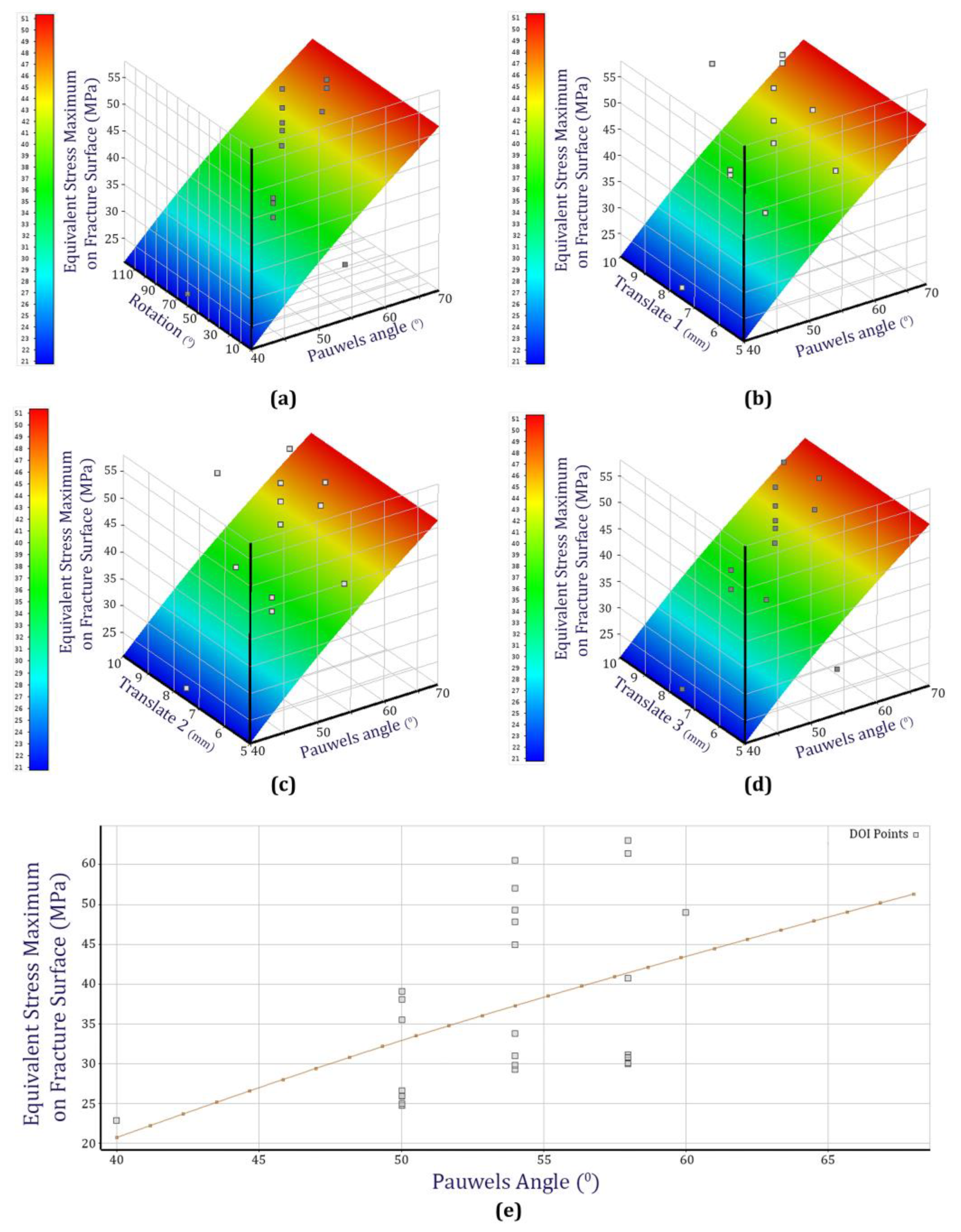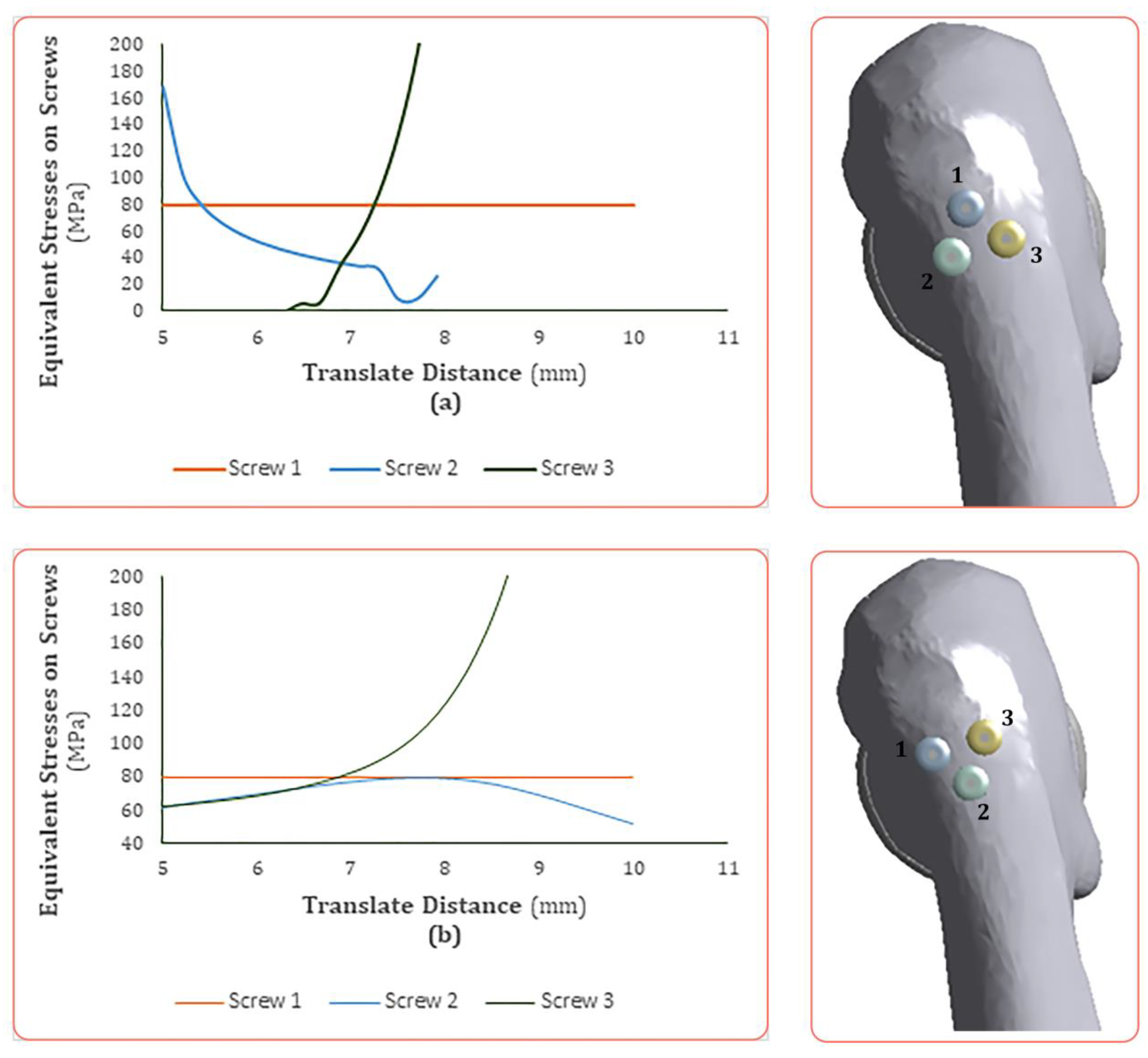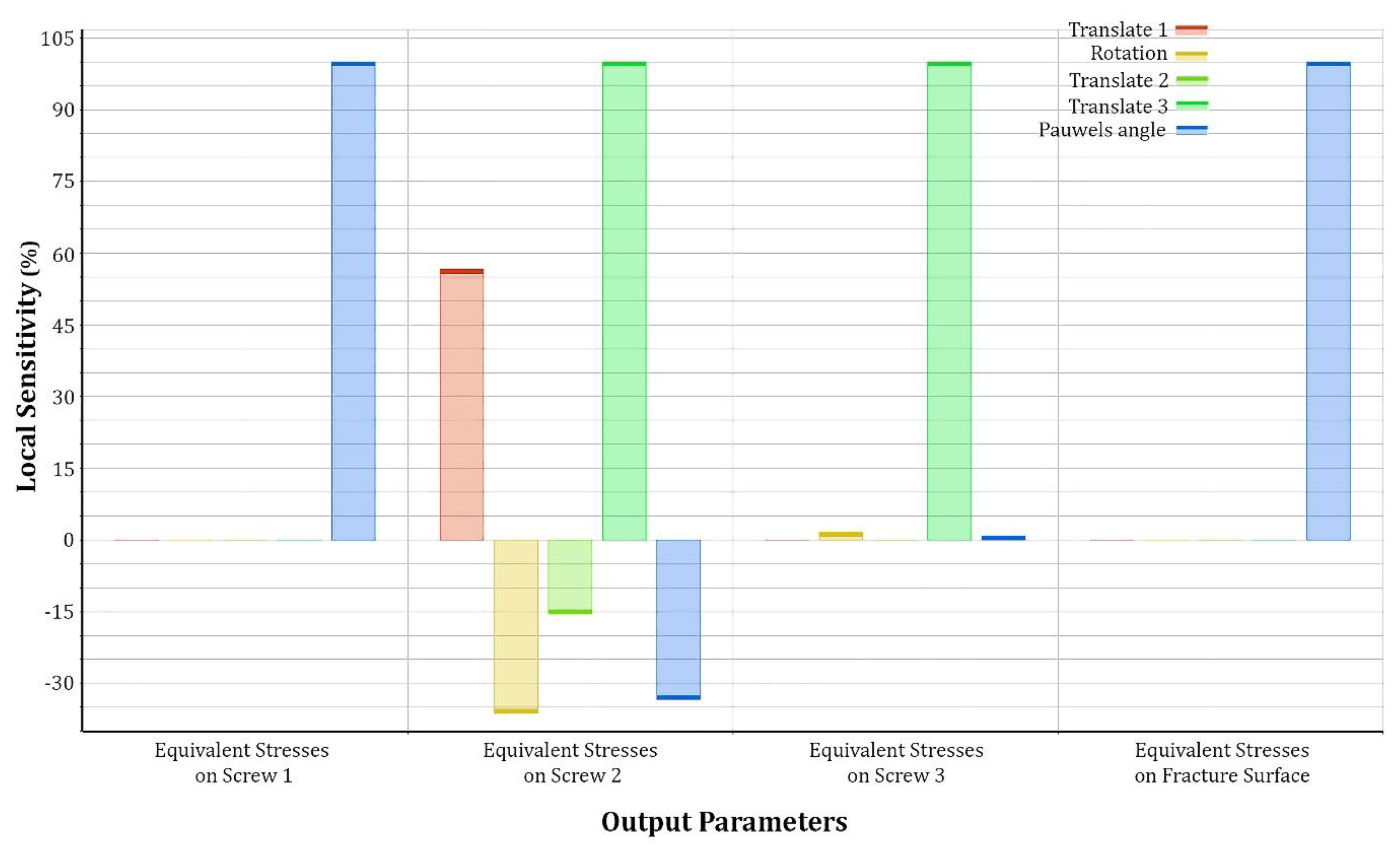Biomechanical Evaluation of Cannulated Screw Optimization for Stabilization of Pauwels Type Femoral Neck Fractures
Abstract
1. Introduction
2. Materials and Methods
2.1. Geometric and Parametric Modeling of FNF Types and Cannulated Screws
2.2. Material Properties, Loading, and Boundary Conditions
2.3. Optimization of Fracture Line and Cannulated Screw Positions
3. Results
4. Discussion
5. Conclusions
Funding
Institutional Review Board Statement
Informed Consent Statement
Data Availability Statement
Acknowledgments
Conflicts of Interest
References
- Cummings, S.R.; Browner, W.; Cummings, S.R.; Black, D.M.; Nevitt, M.C.; Browner, W.; Genant, H.K.; Cauley, J.; Ensrud, K.; Scott, J.; et al. Bone Density at Various Sites for Prediction of Hip Fractures. Lancet 1993, 341, 72–75. [Google Scholar] [CrossRef]
- Zhou, L.; Lin, J.; Huang, A.; Gan, W.; Zhai, X.; Sun, K.; Huang, S.; Li, Z. Modified Cannulated Screw Fixation in the Treatment of Pauwels Type III Femoral Neck Fractures: A Biomechanical Study. Clin. Biomech. 2020, 74, 103–110. [Google Scholar] [CrossRef]
- Jiang, X.; Liang, K.; Du, G.; Chen, Y.; Tang, Y.; Geng, K. Biomechanical Evaluation of Different Internal Fixation Methods Based on Finite Element Analysis for Pauwels Type III Femoral Neck Fracture. Injury 2022, 53, 3115–3123. [Google Scholar] [CrossRef]
- Wang, F.; Liu, Y.; Zhang, C. Effectiveness of F-Shaped Screw Fixation Technique in Treatment of Pauwels Type Ⅲ Femoral Neck Fractures. Chin. J. Reparative Reconstr. Surg. 2018, 32, 1417–1420. [Google Scholar]
- Kuan, F.C.; Hsu, K.L.; Lin, C.L.; Hong, C.K.; Yeh, M.L.; Su, W.R. Biomechanical Properties of Off-Axis Screw in Pauwels III Femoral Neck Fracture Fixation: Bicortical Screw Construct Is Superior to Unicortical Screw Construct. Injury 2019, 50, 1889–1894. [Google Scholar] [CrossRef] [PubMed]
- Chantarapanich, N.; Jitprapaikulsarn, S.; Mahaisavariya, B.; Mahaisavariya, C. Comparative Biomechanical Performance of Two Configurations of Screw Constructs and Types Used to Stabilize Different Sites of Unstable Pauwels Type II Femoral Neck Fractures: A Finite Element Analysis. Med. Eng. Phys. 2022, 107, 1038–1056. [Google Scholar] [CrossRef]
- Wang, G.; Tang, Y.; Wu, X.; Yang, H. Finite Element Analysis of a New Plate for Pauwels Type III Femoral Neck Fractures. J. Int. Med. Res. 2020, 48. [Google Scholar] [CrossRef] [PubMed]
- Mansur, H.; Alvarez, R.; Freitas, A.; Gonçalves, C.B.; Ramos, M.R.F. Biomechanical Analysis of Femoral Neck Fracture Fixation in Synthetic Bone. Acta Ortop. Bras. 2018, 26, 162–165. [Google Scholar] [CrossRef] [PubMed]
- Dong, Q.; Han, Z.; Zhang, Y.G.; Sun, X.; Ma, X.L. Comparison of Transverse Cancellous Lag Screw and Ordinary Cannulated Screw Fixations in Treatment of Vertical Femoral Neck Fractures. Orthop. Surg. 2019, 11, 595–603. [Google Scholar] [CrossRef]
- Zhang, B.; Liu, J.; Zhu, Y.; Zhang, W. A New Configuration of Cannulated Screw Fixation in the Treatment of Vertical Femoral Neck Fractures. Int. Orthop. 2018, 42, 1949–1955. [Google Scholar] [CrossRef]
- Shahzamanian, M.M.; Banerjee, R.; Dahotre, N.B.; Srinivasa, A.R.; Reddy, J.N. Analysis of Stress Shielding Reduction in Bone Fracture Fixation Implant Using Functionally Graded Materials. Compos. Struct. 2023, 321, 117262. [Google Scholar] [CrossRef]
- Viceconti, M.; Olsen, S.; Nolte, L.P.; Burton, K. Extracting Clinically Relevant Data from Finite Element Simulations. Clin. Biomech. 2005, 20, 451–454. [Google Scholar] [CrossRef]
- Wojtaszek, M.; Śleboda, T.; Czulak, A.; Weber, G.; Hufenbach, W.A. Quasi-Static and Dynamic Tensile Properties of Ti-6Al-4V Alloy. Arch. Metall. Mater. 2013, 58, 1261–1265. [Google Scholar] [CrossRef]
- Mei, J.; Liu, S.; Jia, G.; Cui, X.; Jiang, C.; Ou, Y. Finite Element Analysis of the Effect of Cannulated Screw Placement and Drilling Frequency on Femoral Neck Fracture Fixation. Injury 2014, 45, 2045–2050. [Google Scholar] [CrossRef]
- Paternina Baena, J.O.; González Estrada, O.A.; Villegas, D.F. Structural Analysis of Bone by Segmentation and Finite Element Analysis in Patients with Osteoporosis. J. Phys. Conf. Ser. 2021, 2046, 012019. [Google Scholar] [CrossRef]
- Oken, O.F.; Soydan, Z.; Yildirim, A.O.; Gulcek, M.; Ozlu, K.; Ucaner, A. Performance of Modified Anatomic Plates Is Comparable to Proximal Femoral Nail, Dynamic Hip Screw and Anatomic Plates: Finite Element and Biomechanical Testing. Injury 2011, 42, 1077–1083. [Google Scholar] [CrossRef] [PubMed]
- Li, J.; Zhao, Z.; Yin, P.; Zhang, L.; Tang, P. Comparison of Three Different Internal Fixation Implants in Treatment of Femoral Neck Fracture—A Finite Element Analysis. J. Orthop. Surg. Res. 2019, 14, 76. [Google Scholar] [CrossRef] [PubMed]
- Zeng, W.; Liu, Y.; Hou, X. Biomechanical Evaluation of Internal Fixation Implants for Femoral Neck Fractures: A Comparative Finite Element Analysis. Comput. Methods Programs Biomed. 2020, 196, 105714. [Google Scholar] [CrossRef]
- Chen, W.P.; Tai, C.L.; Shih, C.H.; Hsieh, P.H.; Leou, M.C.; Lee, M.S. Selection of Fixation Devices in Proximal Femur Rotational Osteotomy: Clinical Complications and Finite Element Analysis. Clin. Biomech. 2004, 19, 255–262. [Google Scholar] [CrossRef]
- Kilickap, E.; Huseyinoglu, M. Optimization and Modelling of Burrheight by Using Response Surface Methodology and Genetic Algorithm in Drilling AISI 316. J. Eng. Fac. Eng. Dicle Univ. 2010, 1, 71–80. [Google Scholar]
- Shiri, S. A Robust Optimization Approach for Design of a General Purpose Heat Source. J. Space Saf. Eng. 2021, 8, 211–216. [Google Scholar] [CrossRef]
- Pauwels, F. Der Schenkelhalsbruch: Ein Mechanisches Problem. Br. J. Surg. 2005, 23, 874. [Google Scholar] [CrossRef]
- Gupta, R.K.; Sangwan, K.; Kamboj, P.; Punia, S.S.; Walecha, P. Unstable Trochanteric Fractures: The Role of Lateral Wall Reconstruction. Int. Orthop. 2010, 34, 125–129. [Google Scholar] [CrossRef]
- Wang, C.T.; Chen, J.W.; Wu, K.; Chen, C.S.; Chen, W.C.; Pao, J.L.; Chang, C.H.; Lan, T.Y. Suboptimal Outcomes after Closed Reduction and Internal Fixation of Displaced Femoral Neck Fractures in Middle-Aged Patients: Is Internal Fixation Adequate in This Age Group? BMC Musculoskelet. Disord. 2018, 19, 190. [Google Scholar] [CrossRef] [PubMed]
- Tianye, L.; Peng, Y.; Jingli, X.; QiuShi, W.; GuangQuan, Z.; Wei, H.; Qingwen, Z. Finite Element Analysis of Different Internal Fixation Methods for the Treatment of Pauwels Type III Femoral Neck Fracture. Biomed. Pharmacother. 2019, 112, 108658. [Google Scholar] [CrossRef]
- Cha, Y.H.; Yoo, J., II; Hwang, S.Y.; Kim, K.J.; Kim, H.Y.; Choy, W.S.; Hwang, S.C. Biomechanical Evaluation of Internal Fixation of Pauwels Type III Femoral Neck Fractures: A Systematic Review of Various Fixation Methods. CiOS Clin. Orthop. Surg. 2019, 11, 1–14. [Google Scholar] [CrossRef]
- Wang, F.; Liu, Y.; Huo, Y.; Wang, Z.; Zhang, J.; Xu, M.; Ma, K.; Wang, L.; Lu, Y.; Cheng, L.; et al. Biomechanical Study of Internal Fixation Methods for Femoral Neck Fractures Based on Pauwels Angle. Front. Bioeng. Biotechnol. 2023, 11, 1143575. [Google Scholar] [CrossRef] [PubMed]
- Li, J.; Wang, M.; Li, L.; Zhang, H.; Hao, M.; Li, C.; Han, L.; Zhou, J.; Wang, K. Finite Element Analysis of Different Configurations of Fully Threaded Cannulated Screw in the Treatment of Unstable Femoral Neck Fractures. J. Orthop. Surg. Res. 2018, 13, 272. [Google Scholar] [CrossRef]
- Zhang, R.Y.; Li, J.T.; Zhao, J.X.; Zhao, Z.; Zhang, L.C.; Yun, C.; Su, X.Y.; Tang, P.F. Comparison of Oblique Triangular Configuration and Inverted Equilateral Triangular Configuration of Three Cannulated Screws in Treating Unstable Femoral Neck Fracture: A Finite Element Analysis. Injury 2022, 53, 353–361. [Google Scholar] [CrossRef]
- Lindequist, S.; Wredmark, T.; Eriksson, S.A.V.; Samnegård, E. Screw Positions in Femoral Neck Fractures: Comparison of Two Different Screw Positions in Cadavers. Acta Orthop. 1993, 64, 67–70. [Google Scholar] [CrossRef]
- Fortis, A.P.; Dimas, A.; Lamprakis, A.A. Expandable Nailing System for Tibial Shaft Fractures. Injury 2008, 39, 940–946. [Google Scholar] [CrossRef] [PubMed]
- Lin, H.; Lai, C.; Zhou, Z.; Wang, C.; Yu, X. Femoral Neck System vs. Four Cannulated Screws in the Treatment of Pauwels III Femoral Neck Fracture. J. Orthop. Sci. 2023, 28, 1373–1378. [Google Scholar] [CrossRef] [PubMed]






| Components | Modulus of Elasticity (E, GPa) | Poisson’s Ratio (υ) |
|---|---|---|
| Cortical Bone | 16.8 | 0.3 |
| Cancellous Bone | 0.86 | 0.3 |
| Ti6Al4V | 114 | 0.3 |
Disclaimer/Publisher’s Note: The statements, opinions and data contained in all publications are solely those of the individual author(s) and contributor(s) and not of MDPI and/or the editor(s). MDPI and/or the editor(s) disclaim responsibility for any injury to people or property resulting from any ideas, methods, instructions or products referred to in the content. |
© 2024 by the author. Licensee MDPI, Basel, Switzerland. This article is an open access article distributed under the terms and conditions of the Creative Commons Attribution (CC BY) license (https://creativecommons.org/licenses/by/4.0/).
Share and Cite
Verim, Ö. Biomechanical Evaluation of Cannulated Screw Optimization for Stabilization of Pauwels Type Femoral Neck Fractures. Appl. Sci. 2024, 14, 2807. https://doi.org/10.3390/app14072807
Verim Ö. Biomechanical Evaluation of Cannulated Screw Optimization for Stabilization of Pauwels Type Femoral Neck Fractures. Applied Sciences. 2024; 14(7):2807. https://doi.org/10.3390/app14072807
Chicago/Turabian StyleVerim, Özgür. 2024. "Biomechanical Evaluation of Cannulated Screw Optimization for Stabilization of Pauwels Type Femoral Neck Fractures" Applied Sciences 14, no. 7: 2807. https://doi.org/10.3390/app14072807
APA StyleVerim, Ö. (2024). Biomechanical Evaluation of Cannulated Screw Optimization for Stabilization of Pauwels Type Femoral Neck Fractures. Applied Sciences, 14(7), 2807. https://doi.org/10.3390/app14072807




